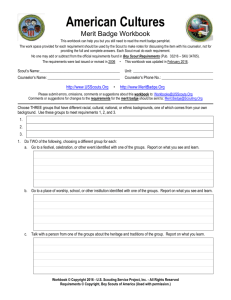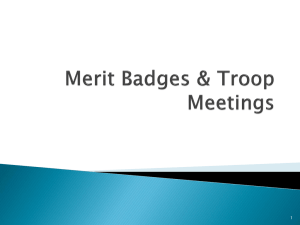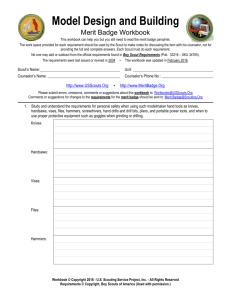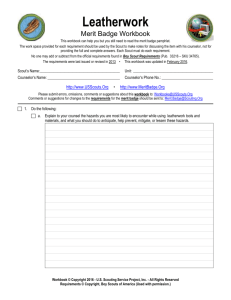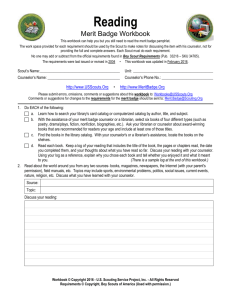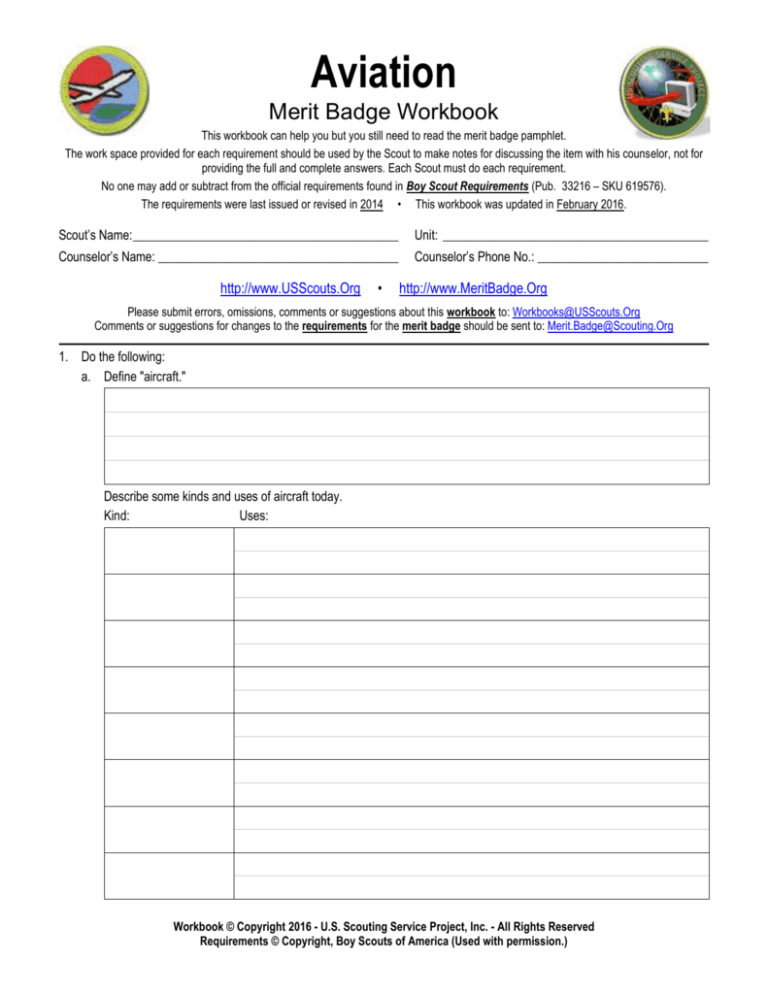
Aviation
Merit Badge Workbook
This workbook can help you but you still need to read the merit badge pamphlet.
The work space provided for each requirement should be used by the Scout to make notes for discussing the item with his counselor, not for
providing the full and complete answers. Each Scout must do each requirement.
No one may add or subtract from the official requirements found in Boy Scout Requirements (Pub. 33216 – SKU 619576).
The requirements were last issued or revised in 2014 • This workbook was updated in February 2016.
Scout’s Name:__________________________________________
Unit: __________________________________________
Counselor’s Name: ______________________________________
Counselor’s Phone No.: ___________________________
http://www.USScouts.Org
•
http://www.MeritBadge.Org
Please submit errors, omissions, comments or suggestions about this workbook to: Workbooks@USScouts.Org
Comments or suggestions for changes to the requirements for the merit badge should be sent to: Merit.Badge@Scouting.Org
______________________________________________________________________________________________________________________________________________
1. Do the following:
a. Define "aircraft."
Describe some kinds and uses of aircraft today.
Kind:
Uses:
Workbook © Copyright 2016 - U.S. Scouting Service Project, Inc. - All Rights Reserved
Requirements © Copyright, Boy Scouts of America (Used with permission.)
Aviation
Scout's Name: ________________________
Explain the operation of piston, turboprop, and jet engines.
Piston:
Turboprop:
Jet:
b. Point out on a model airplane the forces that act on an airplane in flight.
Aviation - Merit Badge Workbook
Page. 2 of 10
Aviation
Scout's Name: ________________________
c. Explain how an airfoil generates lift, how the primary control surfaces (ailerons, elevators, and rudder) affect the
airplane’s attitude, and how a propeller produces thrust.
Airfoil:
Ailerons:
Elevators:
Rudder:
Propeller:
Aviation - Merit Badge Workbook
Page. 3 of 10
Aviation
Scout's Name: ________________________
d. Demonstrate how the control surfaces of an airplane are used for takeoff, straight climb, level turn, climbing turn,
descending turn, straight descent, and landing.
Ailerons
Elevators
Rudder
Flaps
Takeoff
Straight
climb
Level turn
Climbing
turn
Descending
turn
Straight
descent
Landing
e. Explain the following: the sport pilot, the recreational pilot and the private pilot certificates; the instrument rating.
Sport pilot
certificate
Recreational pilot
certificate:
Private pilot
certificate:
Aviation - Merit Badge Workbook
Page. 4 of 10
Aviation
Scout's Name: ________________________
Instrument rating:
2. Do TWO of the following:
a. Take a flight in an aircraft with your parent’s permission. Record the date, place, type of aircraft, and duration of
flight, and report on your impressions of the flight.
Date:
Place:
Type of aircraft:
Duration of flight:
Impressions:
b. Under supervision, perform a preflight inspection of a light airplane.
c. Obtain and learn how to read an aeronautical chart.
Measure a true course on the chart.
Correct it for magnetic variation, compass deviation, and wind drift.to determine a compass heading.
d. Using one of many flight simulator software packages available for computers, "fly" the course and heading you
established in requirement 2c or another course you have plotted.
e. Explain the purposes and functions of the various instruments found in a typical single-engine aircraft: attitude
indicator, heading indicator, altimeter, airspeed indicator, turn and bank indicator, vertical speed indicator, compass,
navigation (GPS and VOR) communication radios, tachometer, oil pressure gauge, and oil temperature gauge.
Attitude
indicator:
Heading
indicator:
Aviation - Merit Badge Workbook
Page. 5 of 10
Aviation
Scout's Name: ________________________
Altimeter:
Airspeed
indicator:
Turn and bank
indicator:
Vertical speed
indicator:
Compass:
Navigation
(GPS and
VOR):
Communication
radios:
Tachometer:
Aviation - Merit Badge Workbook
Page. 6 of 10
Aviation
Scout's Name: ________________________
Oil pressure
gauge:
Oil temperature
gauge:
f.
Create an original poster of an aircraft instrument panel. Include and identify the instruments and radios discussed
in requirement 2e.
3. Do ONE of the following:
a. Build and fly a fuel-driven or battery powered electric model airplane.
Describe safety rules for building and flying model airplanes.
Tell safety rules for use of glue, paint, dope, plastics, fuel, and battery pack.
b. Build a model FPG-9. Get others in your troop or patrol to make their own model, then organize a competition to
test the precision of flight and landing of the models.
4. Do ONE of the following:
a. Visit an airport. After the visit, report on how the facilities are used, how runways are numbered, and how runways
are determined to be "active."
How the facilities
are used
Aviation - Merit Badge Workbook
Page. 7 of 10
Aviation
Scout's Name: ________________________
How runways are
numbered,
How runways are
determined to be
"active."
b. Visit a Federal Aviation Administration facility - a control tower, terminal radar control facility, air route traffic control
center, or Flight Standards District Office. (Phone directory listings are under U.S. Government Offices,
Transportation Department, and Federal Aviation Administration. Call in advance.)
Report on the operation and your impressions of the facility.
c. Visit an aviation museum or attend an air show.
Report on your impressions of the museum or show.
Aviation - Merit Badge Workbook
Page. 8 of 10
Aviation
Scout's Name: ________________________
5. Find out about three career opportunities in aviation.
1.
2.
3.
Pick one and find out the education, training, and experience required for this profession. ___________________________
Education:
Training:
Experience:
Discuss this with your counselor, and explain why this profession might interest you.
Requirement resources can be found here:
http://www.meritbadge.org/wiki/index.php/Aviation#Requirement resources
Aviation - Merit Badge Workbook
Page. 9 of 10
Important excerpts from the Guide To Advancement - 2013, No. 33088 (SKU-618673)
[1.0.0.0] — Introduction
The current edition of the Guide to Advancement is the official source for administering advancement in all Boy Scouts of America programs: Cub
Scouting, Boy Scouting, Varsity Scouting, Venturing, and Sea Scouts. It replaces any previous BSA advancement manuals, including Advancement
Committee Policies and Procedures, Advancement and Recognition Policies and Procedures, and previous editions of the Guide to Advancement.
[Page 2, and 5.0.1.4] — Policy on Unauthorized Changes to Advancement Program
No council, committee, district, unit, or individual has the authority to add to, or subtract from, advancement requirements. There are limited
exceptions relating only to youth members with special needs. For details see section 10, “Advancement for Members With Special Needs”.
[Page 2] — The “Guide to Safe Scouting” Applies
Policies and procedures outlined in the Guide to Safe Scouting, No. 34416, apply to all BSA activities, including those related to advancement and
Eagle Scout service projects.
[7.0.3.1] — The Buddy System and Certifying Completion
A youth member must not meet one-on-one with an adult. Sessions with counselors must take place where others can view the interaction, or the
Scout must have a buddy: a friend, parent, guardian, brother, sister, or other relative—or better yet, another Scout working on the same badge—along
with him attending the session.
When the Scout meets with the counselor, he should bring any required projects. If these cannot be transported, he should present evidence, such as
photographs or adult verification. His unit leader, for example, might state that a satisfactory bridge or tower has been built for the Pioneering merit
badge, or that meals were prepared for Cooking. If there are questions that requirements were met, a counselor may confirm with adults involved.
Once satisfied, the counselor signs the blue card using the date upon which the Scout completed the requirements, or in the case of partials, initials
the individual requirements passed.
Note that from time to time, it may be appropriate for a requirement that has been met for one badge to also count for another. See “Fulfilling More
Than One Requirement With a Single Activity,” 4.2.3.6.
[7.0.3.2] — Group Instruction
It is acceptable—and sometimes desirable—for merit badges to be taught in group settings. This often occurs at camp and merit badge midways or
similar events. Interactive group discussions can support learning. The method can also be attractive to “guest experts” assisting registered and
approved counselors. Slide shows, skits, demonstrations, panels, and various other techniques can also be employed, but as any teacher can attest,
not everyone will learn all the material.
There must be attention to each individual’s projects and his fulfillment of all requirements. We must know that every Scout —actually and
personally— completed them. If, for example, a requirement uses words like “show,” “demonstrate,” or “discuss,” then every Scout must do that. It is
unacceptable to award badges on the basis of sitting in classrooms watching demonstrations, or remaining silent during discussions.
It is sometimes reported that Scouts who have received merit badges through group instructional settings have not fulfilled all the requirements. To
offer a quality merit badge program, council and district advancement committees should ensure the following are in place for all group instructional
events.
Merit badge counselors are known to be registered and approved.
Any guest experts or guest speakers, or others assisting who are not registered and approved as merit badge counselors, do not accept the
responsibilities of, or behave as, merit badge counselors, either at a group instructional event or at any other time. Their service is temporary, not
ongoing.
Counselors agree not to assume prerequisites have been completed without some level of evidence that the work has been done. Pictures and
letters from other merit badge counselors or unit leaders are the best form of prerequisite documentation when the actual work done cannot be
brought to the camp or site of the merit badge event.
There is a mechanism for unit leaders or others to report concerns to a council advancement committee on summer camp merit badge programs,
group instructional events, and any other merit badge counseling issues—especially in instances where it is believed BSA procedures are not
followed. See “Reporting Merit Badge Counseling Concerns,” 11.1.0.0.
There must be attention to each individual’s projects and his fulfillment of all requirements. We must know that every Scout—actually and
personally—completed them.
[7.0.3.3] — Partial Completions
A Scout need not pass all the requirements of one merit badge with the same counselor. It may be that due to timing or location issues, etc., he must
meet with a different counselor to finish the badge. The Application for Merit Badge has a place to record what has been finished—a “partial.” In the
center section on the reverse of the blue card, the counselor initials for each requirement passed. In the case of a partial completion, the counselor
does not retain his or her portion of the card. A subsequent counselor may choose not to accept partial work, but this should be rare. A Scout, if he
believes he is being treated unfairly, may work with his unit leader to find another counselor. An example for the use of a signed partial would be to
take it to camp as proof of prerequisites. Partials have no expiration except the Scout’s 18th birthday. Units, districts, or councils shall not establish
other expiration dates for partial merit badges.
[7.0.4.8] — Unofficial Worksheets and Learning Aids
Worksheets and other materials that may be of assistance in earning merit badges are available from a variety of places including unofficial sources
on the Internet and even troop libraries. Use of these aids is permissible as long as the materials can be correlated with the current requirements that
Scouts must fulfill. Completing “worksheets” may suffice where a requirement calls for something in writing, but this would not work for a requirement
where the Scout must discuss, tell, show, or demonstrate, etc. Note that Scouts shall not be required to use these learning aids in order to complete a
merit badge.
Attachment
(NOTE: It is not necessary to print this page.)
Page 10 of 10



